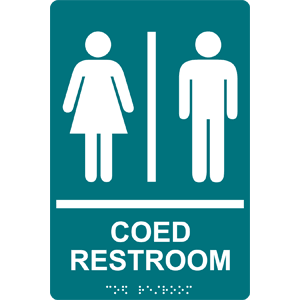Emily Bazelon’s article, “Making Bathrooms More Accommodating”, points out the hypocrisy of accommodating certain people while refusing to do so for others when it comes to public restrooms. Are “public” restrooms really public if certain people are not allowed in? Bazelon focuses in on the transgender population and how it is seen as a social norm violation to enter a bathroom based on the gender they identify with, not what they were born as.
The article starts off by introducing the audience to the fact that bathroom signage is a sexual divider that we see everyday. These signs let us know which door is appropriate to enter. Bazelon thinks that it is absurd for a woman to wait in line when the men’s room next door is empty. Since the early 19th century, men and women have had separate bathroom facilities. This has been a social norm for so long that in today’s world it seems taboo to have unisex restrooms. One concern that the public has, which Bazelon touches on briefly, is sexual assault. Voters in Houston, Texas recently rejected an equal rights ordinance. The ordinance addressed preventing discrimination in housing, employment, and public spaces, but the opposing side focused specifically in on bathrooms. Bazelon writes, “They created ‘‘No Men in Women’s Bathrooms’’ T-shirts and a TV ad with sinister images of a man threatening a girl in the stalls, successfully playing on voters’ fears” (Bazelon, lines 19-20). The issue of equality in public restrooms only gets messier when it comes to the transgender population.
Bazelon’s article touches on several different issues dealing with the accommodation of public restrooms but her main focus is the right transgender people should have to enter the bathroom they feel most comfortable in. First off, the word accommodate means to be mindful of the needs of others and adjust to them. Or in harsher terms, accommodation can sometimes feel like stepping aside to make room for others, whether you like it or not (Bazelon, lines 47-48). People have trouble accommodating to a certain group’s needs, especially when they see it as outside of social norms. Bazelon elaborates by using several transgender rights issues that have come up in the school system. A transgender student at a high school in Illinois requested access to the women’s locker room; she is undergoing hormone treatment and has an ID that states she is female. The school rejected her request due to privacy issues and suggested she use a separate room down the hall. After the student’s family filed a civil rights complaint, the United States Department of Education stepped in and she was granted permission to use the women’s locker room with her female classmates (Bazelon, lines 28-40). Much like this girl’s want to fit in and share facilities with the gender to which she associates herself, women all over the world have become fond of “the ladies room”.
Women, and men alike, treat the bathroom as a sort of safe haven. Where they can go to chat and get away from the outside world. Just like everyone else, transgender men and women want to be a part of these social habits. Accommodate is a good word to use when it comes to public facilities, but it only covers the basics. For those with disabilities it means a bar next to the toilet, a button to open the door, or brail on the restroom sign (Bazelon, lines 119-121). But, when it comes to those that are transgender, the word “accommodate” just does not cover it. The changes needed to make transgender individuals feel comfortable and accepted are going to have to first start with a change in society’s mindset and heart. Overall, Bazelon presents thoughtful information that sparks the thought in reader’s minds that public restrooms really do not accommodate everyone, which is a concept overlooked by most, and it needs to change.
Work Cited
